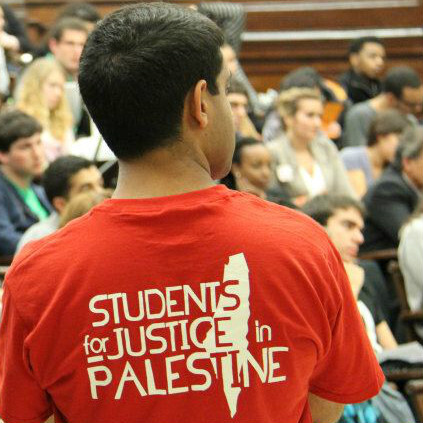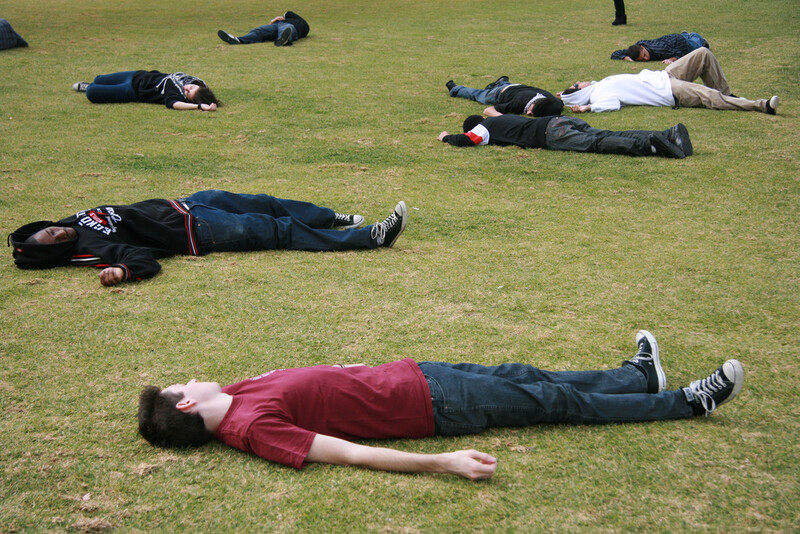Activism and BDS Beat 8 November 2012

I’ve recently returned from the second national conference of Students for Justice in Palestine, held this past weekend in Ann Arbor, Michigan. This invigorating and well-organized event addressed chronically-overlooked issues (such as gender dynamics within the movement), offered a wealth of practical training in key organizing skills, responded to unforeseen events quickly and effectively, and sent hundreds of young organizers back to campuses around the US energized, determined and better equipped than ever to handle the challenges ahead.
Curiously, this was actually the second time I had attended a second national conference of Students for Justice in Palestine in Ann Arbor, Michigan. The first time was just over ten years ago, at an event titled “Second National Student Conference on the Palestine Solidarity Movement.” The first National Student Conference of the Palestine Solidarity Movement had been held at the University of California at Berkeley only eight months earlier (click the links to read accounts of the conferences on their now-defunct websites).
The first gathering was convened by the newly-founded Berkeley Students for Justice in Palestine in an effort to build a national coordination mechanism for campus-based Palestine solidarity activists in the United States. Despite the fact the Palestinian Civil Society Call for Boycott, Divestment and Sanctions would not be issued until 2005, the coalition which emerged from the Berkeley conference, known as the Palestine Solidarity Movement (PSM), made divestment from Israel the centerpiece of its program.
PSM went on to hold three more official conferences at Ohio State University (Columbus, Ohio, 2003), Duke University (Durham, North Carolina, 2004) and Georgetown University (Washington, DC, 2006). The coalition also expanded to include non-student organizations, as well as a handful of Canadian groups. At its height, the coalition included several hundred member organizations.
Despite the best efforts of large numbers of extremely talented and committed people, the PSM eventually collapsed. It was not until 2009 that another national student conference was held (at Hampshire College in Amherst, Massachusetts), and not until 2011 that the first national conference of Students for Justice in Palestine (in its current incarnation) was held at Columbia University in New York City. Another national conference (though with a less explict focus on student groups) was convened by Penn BDS at the University of Pennsylvania (in Philadelphia) in February, 2012.
Although there were many contributing factors to the decline of PSM, as well as to the failure of the 2009 Hampshire conference to result in the development of new national coordination mechanisms, one of these was undoubtedly a lack of continuity with, and opportunities learn from, experiences of the past.

I cannot recall a single discussion within PSM (with which I was heavily involved) regarding the history of campus Palestine solidarity organizing prior to the formation of Berkeley SJP. Most of us, I think, were aware that there had been past activity, particularly in the wake of the 1967 war, the 1982 invasion of Lebanon, and the 1987 outbreak of the first intifada, but few of us had any awareness of the specifics. We were certainly unaware of any past efforts to coordinate these activities nationally, and did not seek, in any significant way, to infer relevant lessons from other movements. The movement to end apartheid in South Africa was a constant source of inspiration, but was never seriously explored in terms of its utility as a model of possible coordination structures.
The importance of preserving history
Approximately 70,000 Palestinian books were systemically stolen by the newly-established state of Israel in 1948. During Israel’s 1982 assault on Beirut, the massive archive of Palestinian films maintained by the PLO vanished without a trace. In 2002, Israeli forces rampaged through the West Bank, looting and destroying archive after archive, from the Khalil Sakakini Cultural Center to Orient House to the Ministry of Education. Today, Palestinian citizens of Israel are prevented by law from commemorating their own dispossession.
With Palestinian history under such constant threat, with Israel so determined to sever new generations of Palestinians from their culture and past, how can we ignore the importance of documenting and learning from history of the global solidarity movement for Palestine human rights, especially when that history includes critical lessons for carrying our movement forward instead of constantly reinventing the wheel?

Palestinian refugees, October 1948
Our movement has greater potential now than at any time in its past. But as incredible and invigorating as the 2012 National Conference of Students for Justice in Palestine was, as far ahead of earlier efforts as it was in many respects, it still concluded by resolving to undertake from scratch some of the very same projects that we resolved to undertake in 2002 (and even in 2001), but never completed. The surest means of unlocking the vast and growing potential of our movement is to take the time to learn about its history, to understand what has worked, what hasn’t worked, and why, and to infuse our organizing with that knowledge.
For newer activists, particularly in a historical moment such as this, there is a natural feeling that they can succeed on their own, learning each lesson for themselves, that shifts in the political landscape, in technology, or elsewhere have rendered even the lessons derived from our most recent history all but irrelevant.
It’s true. Things have changed. Dramatically. This generation of activists can and will succeed where others have failed. We will see justice in Palestine within our lifetimes. But if we have the chance, just maybe, to make that happen even a little bit sooner, so that just a few less children have to be born in the shadow of sniper towers, under a cloud of white phosphorus, so just a few more elderly survivors of the Nakba can step foot in their villages one last time before they draw their final breath … shouldn’t we at least give it the old college try?
A partial reading list
There are few analyses of this history available, and more need to be written, but these will get you started. This is anything but a comprehensive list, and I strongly encourage readers to post additional suggestions in the comments section. My focus here is on recent history, and in particular, the history of efforts to establish coordinating mechanisms for campus-based activism.
Before the 1980s
As speaker Hatem Bazian noted at this past weekend’s SJP conference, some form of political organizing in support of Palestinian rights has been taking place in the United States since even before the Nakba. These first few decades of organizing history are among the least well known, and analyses thereof have been confined mainly to academic journals. With the establishment of the PLO in 1964, the General Union of Palestinian Students (GUPS) became a major component of Palestinian rights organizing within the diaspora. The Oslo accords ended the formal existence of GUPS as a component of the PLO. There’s obviously far more to be said here, and I’d encourage anyone with knowledge of good resources, particularly on GUPS, to suggest them within the comments section.
The best starting point for general research into this period is probably the archives of the Journal of Palestine Studies. In addition, San Francisco State University professor Rabab Abdulhadi has published Activism and Exile: Palestinianness and the Politics of Solidarity, exploring Palestinian solidarity activism from the 1960s, and the website of the now-defunct Palestine Solidarity Review contains several articles on the history of campus-based Palestine solidarity organizing in the 1960s and 1970s.
1980s-1990s
The website of the defunct New Jersey Solidarity, established at Rutgers University (New Brunswick) in 2002, is still active and includes four scanned issues of the PLO Information Bulletin, an interesting primary source for those interested in the PLO’s mass communications (in English) with foreign solidarity activists, who comprised a significant portion of its readership. The issues online were published between 1978 and 1982.
In 1984, AIPAC published the AIPAC College Guide, containing an analysis of the overall landscape of campus-based Palestine solidarity organizing in the United States at the time. The chief author of the book was Jonathan S. Kessler, who still oversees AIPAC’s anti-Palestinian advocacy efforts at US colleges and universities. The majority of the book is comprised of profiles describing Palestine solidarity activities on 100 different campuses, each one contributed by leading anti-Palestinian activists at their respective college or university. Among those volunteering to “name names” and denounce Palestinian human rights advocates on their campus was Wayne Firestone. The young Firestone went on to become head of the Israel on Campus Coalition, and is now the President of Hillel: The Foundation for Jewish Campus Life, the largest Jewish campus organization in the world, which sadly devotes a massive proportion of its activities to anti-Palestinian advocacy.
The oldest extant campus-based Palestine solidarity group in the United States, Oberlin Students for a Free Palestine, was founded in the 1980s, thus predating even Berkeley SJP. The organization became temporarily defunct in 1998, but reemerged in the early 2000s. Former Oberlin student Rachel Marcus authored a paper on the history of SFP, and although the paper is not available online as of this writing, I hope to update this post soon with details on how to access it.
In 1999, a merger of the Concordia Centre for Palestinian Human Rights (CCPHR) and the McGill Palestinian Solidarity Committee (PSC) resulted in the formation of Solidarity for Palestinian Human Rights (SPHR). In 2001, SPHR was restructed as a national umbrella organization for campus-based Palestine solidarity activists in Canada, developing a significant infratructure and growing to include at least a dozen branches. The organization no longer exists on a national level. However, as the most successful effort to date to develop a national coordination mechanism for student-led Palestine solidarity organizing, detailed analyses of the factors influencing SPHR’s rise and fall would be a valuable contribution to the movement.
2000-present
In 2006, Eyad Kishawi published Divestment From Israel In Its Fifth Year: A history and method for US and European activists. Partly historical analysis, and partly a strategy proposal, the paper explores the evolution of campus divestment organizing in the early 2000s.
Also in 2006, student activists in the United Kingdom established Action Palestine, a UK-wide body linking organizers at over 15 campuses. Action Palestine’s national website is defunct as of 2011, but local Action Palestine groups remain active on many UK campuses.
In 2008, I was asked to contribute a series of case studies on BDS campaigns in the United States to Badil’s journal al-Majdal. As one component of the larger piece, “In the Belly of the Beast: Boycott, Divestment, and Sanctions Campaigns in the United States,” I discuss the development of national coordination mechanisms for US campus BDS efforts from 2000 onward, and analyze the reasons behind their decline after 2006.
Israel’s 2009-2010 assault on Gaza led to the formation of a national coordinating body of campus-based in Australia. Initially known as Students for Gaza, the group later changed its name to Students for Palestine. It remains active on at least five campuses.
In the summer of 2010, Berkeley SJP co-founder, PSM organizer and noted scholar Noura Erakat authored BDS in the USA, 2001-2010, appearing in issue 255 of the Middle East Report. The article explores the evolution of both on-campus and off-campus BDS organizing in the United States, beginning with the early efforts of Berkeley SJP.
In 2011, I was asked to provide another account of the rise and fall of PSM for the program that was distributed at the first National Conference of Students for Justice in Palestine in New York City. This updated reflection, Students for Justice in Palestine: A Decade of Campus Activism, included an account of the 2009 Hampshire College conference, situated within the borader history of campus Palestine solidarity organizing over the preceding decade.
The future
There continues to be a scarcity of material analyzing the history of campus Palestine solidarity organizing throughout the world. Studies of the Canadian, British, and Australian efforts to build national campus coordination mechanisms through SPHR and Action Palestine would be a particularly important contribution to the literature, as would studies of coordination efforts in other countries, and of US efforts prior to the 2002 establishment of PSM.
In addition to studies of meta-organizing efforts, more local and regional analyses, such as Rachel Marcus’ paper on the history of Oberlin SFP, would also be helpful. University archives, and campus newspapers in particular, contain a wealth of information, but will require significant effort to evaluate. Wherever possible, efforts should be made to make more primary sources available online for further study.
Even more important than expanding the range of material available to activists and scholars is for today’s organizers to commit themselves to developing at least a rudimentary understanding of past efforts, and the reasons for their relative success and failures. Despite the unique characters of today’s political, social and technological landscape, many of the lessons learned by past organizers remain relevant, and perhaps even vital.
There remains much to be done to perfect the wheel, but Palestinians throughout the world have waited more than sixty years to see their most fundamental human rights restored. Our movement does not have the luxury of time to reinvent the wheels that have carried us this far.
“Those cannot remember the past are condemned to repeat it” - George Santayana.
“You must learn” - KRS-One.






Comments
Association of Arab-American University Graduates
Permalink JJ replied on
Would be great to connect this with the tremendous work done by the AAAUG from 1970-1989, especially with Ali Abunimah's call for an alumni support effort for SJP. The AAAUG did some incredibly work including critical scholarship and publishing about Israeli domestic and foreign policy. http://www.ihrc.umn.edu/resear...
History of the Palestine Solidarity Movement in the US.
Permalink Dick Reilly. replied on
One book overlooked here that provides fairly detailed accounts of the type of student and community solidarity work and coalition building done across the US during the first Intifada is: "INTIFADA: The Palestinian Uprising Against Israel Occupation", edited by Zachary Lockman and Joel Beinin and published by South End Press. ( c1989). Worth revisiting
Stealing Their Homeland
Permalink JohnWV replied on
Besieged Palestinian Gaza is an experiment in provocation. Stuff one and a half million people into a tiny space, stifle their access to water, electricity, food and medical treatment, destroy their livelihoods, and humiliate them regularly...and, surprise, surprise - they turn hostile. Now why would you want to make that experiment? Because the hostility you provoke is the whole point. Now under attack you can cast yourself as the victim, and call out the helicopter gunships and the F16 attack fighters and the heavy tanks and the guided missiles, and destroy yet more of the pathetic remains of infrastructure that the Palestinian state still has left. And then you can point to it as a hopeless case, unfit to govern itself, a terrorist state, a state with which you couldn't possibly reach an accommodation. And then you can carry on with business as usual, quietly stealing their homeland.